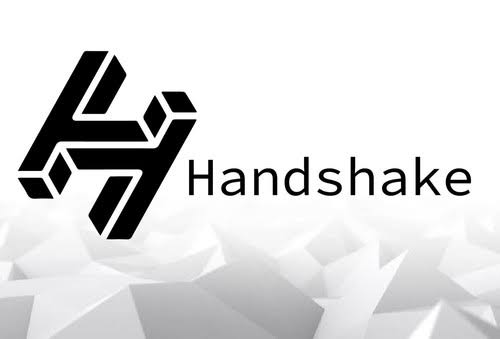Handshake (HNS)
What Is Handshake (HNS)?
Handshake is a decentralized permissionless system that is intended to incentivize a distributed network of computers to operate a system for domain name ownership.
Under Handshake, every peer is tasked with validating and managing the root DNS naming zone, with the objective of providing an alternative to current certificate authorities and naming systems.
Different participants across the internet such as social networking handles and domains rely on a centralized approach. This means the systems depend on a system of honesty — and are still prone to cyber attacks and fraud.
Handshake aims to eradicate this problem by creating a decentralized internet that relies on a peer-to-peer system.
Who Are the Founders of Handshake?
Joseph Poon and Andrew Lee are the two main co-founders of Handshake.
Lee quit a job at Merrill Lynch to co-found Purse — one of the largest marketplaces for Bitcoin in early 2014. As Purse expanded, he began to explore other ways of innovating in the marketplace and investing in infrastructure.
He and Poon had been discussing the ideas underpinning Handshake for years before they co-founded the company.
Aside from developing Handshake, Poon co-wrote the Plasma Papers in collaboration with Vitalik Buterin, the co-founder of Ethereum.
Poon worked at a Big Four accounting firm before becoming involved in the crypto space, while in between jobs. He’s also the co-creator of the Lightning Network and Plasma.
Other co-founders include Boyma Fahnbulleh and Christopher Jeffrey.
Who created Handshake?
Handshake is the product of a group of technologists with deep involvement in cryptocurrency.
This group includes Joseph Poon, who helped to create Bitcoin’s Lightning Network and Christopher ‘J.J.’ Jeffrey, the CTO of early bitcoin startup Purse.
The Handshake team has so far attracted $10.2 million in investment from a cast of prestigious venture capital firms. These include Andreesen Horowitz, Draper Associates and Peter Thiel’s Founders Fund. A total of 67 investors took part in the funding round.
Investors received 7.5% of the initial supply of 1.36 billion HNS.
The Handshake Launch
Of note is that Handshake’s creators tried to jumpstart the disruption of the HNS cryptocurrency by pricing and distributing HNS tokens creatively.
After setting aside about 15% of HNS tokens for developers and investors, the team proceeded to give away the remainder of the initial supply, with 68% going to open-source developers.
The rest of the HNS was allocated to the owners of the web’s top websites, ICANN and CAs, as Handshake’s creators reasoned that all parties with an interest in domain names would need an incentive to adopt their new system.
Handshake officially launched on February 3, 2020.
How does Handshake work?
Put simply, Handshake is a system for distributing website addresses through auctions.
With Handshake, auctions for top-level domain names are held every two weeks. Users must bid Handshake’s cryptocurrency, HNS, to take part in the auction.
The winning bidder pays the second-highest price, using a format known as a Vickrey auction. These auctions are all handled automatically by the Handshake software.
The Handshake Blockchain
The Handshake blockchain shares several similarities to the Bitcoin blockchain. For example, miners running the Handshake software compete to unlock newly minted HNS tokens by solving mathematical puzzles and adding blocks to the Handshake blockchain.
As on Bitcoin, new blocks are added to the blockchain every 10 minutes. Further, like Bitcoin, Handshake has a fixed 2.04 billion limit on the supply of HNS that can ever be created.
Handshake miners are paid 2,000 HNS every 10 minutes for performing this task.
Creating Handshake Domain Names
Handshake names must be claimed in an auction. All possible Handshake names will be available for bidding within a year of the Handshake network’s launch.
A user who wishes to create a Handshake name needs to check that it’s available, and then send a special transaction to the network that opens an auction.
The network’s algorithm will then determine when that auction will take place.
Handshake names can be used in a variety of ways. For example, they can be used to point to a website, but they can also be used as an address for a cryptocurrency wallet.
Name Claims and Name Auctions
Notably, the 100,000 web addresses with the most traffic, as measured by Alexa, are being set aside on Handshake for their current owners to prevent abuse of the system.
Owners of those websites can claim a Handshake name by issuing a cryptographic proof.
Auctions are the main way Handshake names are acquired. Users can bid for names roughly every 14 days. Bids are private and the highest bid wins.
What Makes Handshake Unique?
One of the most unique features of Handshake is that it is not a blockchain project looking to fully decentralize current DNS infrastructure. It is rather about decentralizing the root zone — and/or the top-level domains.
This is because apart from the root zone, the entire of DNS is already decentralized.
Handshake’s white paper states: “the Handshake naming protocol differs from its predecessors in that it has no concept of namespacing or subdomains at the consensus layer. Its role is not to replace all of DNS, but to replace the root zone file and the root servers.”
A key concept about Handshake is that it aims to decentralize or reduce dependence on the Internet Corporation for Assigned Names and Numbers (ICANN.)
ICANN was launched in 1998 as a non-profit partnership made of people across the globe, with the aim of keeping the internet more secure.
Handshake instead aims to use a decentralized application based on Proof-of-Work principles to improve the security of the internet.
How Is Handshake Secured?
Handshake is secured using the unspent transaction output (UTXO) of the blockchain and uses the principles of proof-of-work (PoW) in the same way as Bitcoin.
The naming system comprises on-chain smart contract features which are known as covenants, which are intended to limit the use of future transaction output.
Tags:
Cryptocurrency
